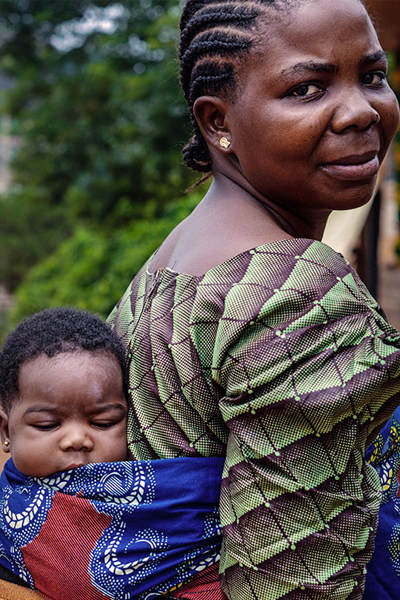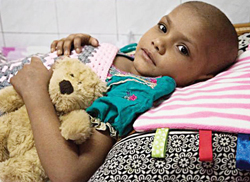
Traditionally thought and seen as a lifestyle disease for the well-to-do and the aged, the increasing cases of children with cancer today baffles many people.
At the Kenyatta National Hospital Children Oncology Ward, you will find angelic, innocent, and beautiful children battling cancer. Some of them have been in the ward for months. Others have been there for years, mostly due to non-payment of bills, the difficult treatment regimen for children and critical state of their terminal illness.
The only respite for children is speedy treatment and being creatively engaged while at the wards. Indeed, the Kenyatta National Paediatric Cancer Ward 1E is painted in bright yellow colours, with cartoon illustrations on the walls. But this is not all or enough. Well-wishers, families and organisations often hold fun activities at the wards to alleviate the children’s boredom and pain.
At the Moi Teaching and Referral Hospital (MTRH) in Eldoret, the Sally Test Child Life Programme provides educational and recreational activities for children. It creates a nurturing environment for children and even adults.
Like adults, children are afflicted by different types of cancers, the most common being eye cancer. Other common cancers in children are lymphomas and leukaemia.
Even though 80 percent of cancers are curable, the cure rates in Kenya are very low. According the World Child Cancer Organisation, only 20 percent of children with cancer in Kenya survive. This contrasts sharply with the developed nations, where up to 80 percent of children with cancer survive. This sad state of affairs is attributed to late diagnosis, lack of specialised training and the heavy cost of treatment.
Indeed, a recent study titled Access to Financial Burden for Patients with Cancer in Ghana, Kenya and Nigeria, which looked at breast cancer treatment in the three countries, showed that a patient’s chances of survival is determined by delays in diagnosis and treatment, access to appropriate and quality care, and more importantly, cost.

study, commissioned by global biotech company, Roche, and led by Dr. Majid Twahir of Aga Khan University Hospital, Kenya, and Razaq Oyesegun of National Hospital in Abuja, showed that patients travel long distances to access treatment in the three countries. In Kenya, that is about 398 kilometres.
When it comes to children and cancer, the major treatment centres are the Kenyatta National Hospital and MTRH. The latter diagnoses about 100 to110 children with cancer per year.
The World Child Cancer Organisation stated that while the National Health Insurance Fund (NHIF) caters for treatment, it does not cover the whole cost and thus, most families are forced to pay from the pocket.
Perhaps, the study, Influence of Health Insurance Status on Childhood Cancer Treatment Outcomes in Kenya better expounds this. The retrospective study looked at all the children diagnosed with a malignancy from 2010 to 2012, with data on treatment outcomes and health insurance status at diagnosis abstracted from patient charts.
The study’s findings indicated that of the 280 patients sampled, 34 percent abandoned treatment, 19 percent died, and 18 percent had progressive or relapsed disease, resulting in a 29 percent event-free survival.
Sixty-five percent of the patients did not have health insurance at diagnosis. Treatment results differed significantly between patients with different health insurance status at diagnosis – 37 percent of uninsured versus 28 percent of insured patients abandoned treatment; while 24 percent of uninsured versus 37 percent of insured patients had event-free survival.
Of patients without health insurance at diagnosis, 77 percent enrolled during treatment. Among those patients who later enrolled for health insurance, the frequency of progressive or relapsed disease and death was significantly lower, while the event-free survival estimate was significantly higher compared to those who had not enrolled.
This shows the importance of having health insurance like NHIF, which is still not available to everyone, the reason the government is pushing for UHC.
The hospital administration at MTRH states that NHIF pays for most of the cancer services, including CT scans, MRI, surgery, chemotherapy and radiotherapy, admission and bed fees. It has an NHIF clinic at its premises and it encourages patients to register.
The MTRH treats cancer patients through its Directorate of Haemoto-Oncology, whose objective is to prevent, diagnose early, and comprehensively treat diseases of the blood and cancer.
Started in 2005 as a volunteer service, it grew over the years to become a fully-fledged directorate in 2016. In 2005, it was treating 50 patients, a number which has since risen to over 8,000 patients. It collaborates with world-renowned teaching schools like Ivy League Brown University, Harvard Medical School, University of Toronto, and others.
Besides outpatient clinics at MTRH, the directorate runs outreach programmes in western Kenya, including Busia, Kitale, Bungoma, Kakamega, Turbo and Webuye.
The hospital provides free breast and cervical cancer screening services five days a week, as well as through outreach medical camps. This is in a bid to sensitise people on the need for early diagnosis. Diagnosis includes fine-needle aspiration cytology and biopsies. Treatment, including chemotherapy, is done at the hospital, which has strived to make the premises as comfortable as possible.
The hospital has gradually positioned itself as the go-to facility for cancer patients, not only from Nyanza and Western region, which it serves, but Nairobi too. Indeed, patients with the aggressive type of breast cancer, known as HER2-Positive – the Human Epidermal Growth Factor Receptor 2 Positive – find that treatment in Nairobi is way too expensive, but affordable at MTRH. Thus, patients travel many kilometres for treatment here.
At the Kenyatta National Hospital, besides NHIF, organisations like Faraja Trust also chip in. Through its Faraja Medical Support Fund, the trust strives to have all children and adults diagnosed in Kenya able to access the right, affordable treatment at the right time.
